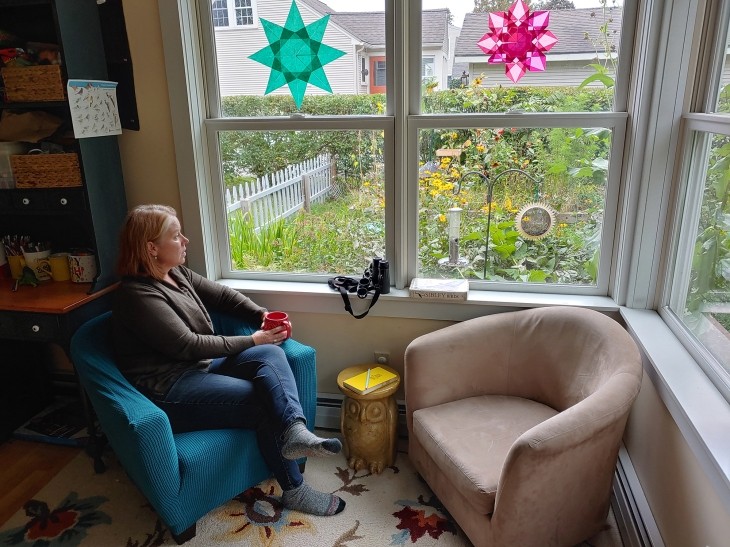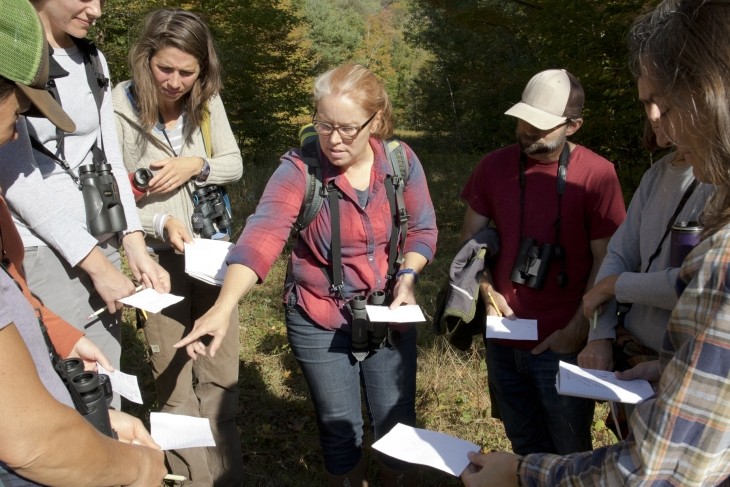
Bridget Butler is a naturalist, conservationist, and birder in northern Vermont. With decades of experience in conservation and education, she now serves as the executive director of Friends of Northern Lake Champlain. Also known as the “Bird Diva,” she leads birding outings, offers online courses, and builds community around her philosophy of “Slow Birding,” a way of bringing deep listening and mindful connection into the birding experience.
I grew up in Cazenovia, just outside of Syracuse. That part of New York state is rolling hills and forests and a mash-up of agriculture land, and not far from the edges of the Great Lakes. I was born in the 1970s, and my sister Amy and I were part of the latchkey generation of kids, where both of our parents were working. We fended for ourselves, and most of the time, what that looked like was being outside after school. The kids in the neighborhood were spread out because we were on a very rural road, so there were places that we would meet up: the big creek or the big tree. We had the run of the place, and I had this sweet, banana seat bike that was a lavender color and we would just rip around. My mom would get frustrated with me for bringing garter snakes home and worms and things like that.
My grandparents lived on Cape Cod, so we would go for two weeks every summer. It sparked an interest in marine biology. My degree is in marine and freshwater biology; I thought I wanted to be a research scientist. I studied invertebrates. Everyone else was into dolphins and whales and I was like, “Look at this nudibranch, it’s the coolest thing!” But it all came crashing down because I didn’t do well on boats: I got seasick, so that was the end of that. It was good because it pushed me into being a generalist and really into being a naturalist.
After college I worked in nature centers across New England, starting with things that were coastal. I first worked for Massachusetts Audubon on Cape Cod, and that’s how I got connected to the birding world. It didn’t start off very well – I thought birders were obnoxious and gatekeep-y. I worked at a beautiful place called the Wellfleet Bay Wildlife Sanctuary, which is a hotspot for shorebirds and migrating birds. Birding there was hard to break into because you really had to know your stuff, and there wasn’t a lot of forgiveness for not knowing. I got really turned off by the way some of the birders there treated beginners.
A lot of people assume I have been birding since I was a kid, but I actually only got into it in my late 20s and early 30s. I moved up to Jay Peak, Vermont because I heard it got the most snow in the Northeast. For a while I was a ski bum: I taught skiing and snowboarding, and in the off season I would go to New Zealand and teach over there. After a while, I missed connecting people with nature. I started working at Audubon Vermont and I found the coolest group of birders there. None of us were expert birders then, and it was much more laid back and welcoming.
We took this beginner’s mindset around birding and applied it to our conservation work. That’s where the Foresters for the Birds program came from. We did strategic planning and thought, “What can we be really good at in Vermont?” Vermont is forested, and most of that forested land is owned privately. With Foresters for the Birds, we gave landowners and foresters a smaller subset of birds that were common and accessible to learn. We were going for birds that people could have an experience with. It was amazing: people would come in passionate about the land they own or manage, telling all these stories, and our job was to find that bird that would help them make a connection with smart management practices. Birds are an amazing conduit for getting people to take action. I realized there are these different modalities of birding, and with my work at Audubon it was really about conservation intention.
I loved that approach, but there was this small gap that was there. It’s hard to describe – it was a feeling of something missing that I wasn’t experiencing yet, but that I was longing to experience. Part of it was that I wanted to know more about bird behavior. A lot of surveys are just presence or absence: are there these birds on the landscape or not? I would have these moments where I would see a bird do something beyond what I had been trained to notice, and I wanted to know more. I had been following the work of Jon Young, a naturalist and tracker, especially his work on bird language. I attended an immersive workshop in Maine as a participant and eventually a facilitator for White Pine Programs, a nature education center. Beyond my work, I kept reaching out to explore who else was doing stuff outside of traditional birding.
After Audubon Vermont I worked a lot of other jobs: on Hog Island for Audubon Maine, back in Vermont for ECHO, Cold Hollow to Canada, and I now work at Friends of Northern Lake Champlain. My birding work was more on the side, but it started to grow. I chose the name “Bird Diva” mostly because the name was free. I’m not much of a diva…but it sounds good! And I will embrace the sassy sound as far as standing by the arc of my work, so maybe that’s where the diva piece comes in. I started doing some online work, holding outings, and writing and talking more about my birding philosophy. This was really at the start of the pandemic and there was this explosion of people interesting in birding.
I noticed a lot of beginners would start a conversation with, “I’m not a birder but…” and go on to tell a beautiful story of something they had observed with birds. I was like, “All these people are saying that they’re not birders, but they are!” There was a disconnect, and I felt it too. When you put on the identity of being a birder, there are all these expectations. Even though I was a very skilled bird walk leader, I still felt that tension and competition. Sometimes I was being judged as a leader, and sometimes I was watching and listening to people trying to come into birding and seeing them being judged. I wanted to lead walks differently; I wanted to move away from this role of there being an all-knowing person. I wanted to empower people and for them to realize they can go out on their own and have an amazing birding experience.
My philosophy for slow birding came from these experiences. The idea is: we gather, we walk together, we get to know the landscape, everyone does a sit spot practice, then we come together again and reflect. When we come upon a bird, we all help describe where it is. I ask people to not name the bird at first. Sometimes once you name it, your brain stops, because you know what it is, so you move on. I want people to stay in the experience. We describe what we’re noticing about the bird out loud. It’s a beautiful thing because anyone can take part, and you’re sharing with others and processing together. It becomes a collective thing where we’re working together to know the bird, rather than having the people who know and the people trying to gain knowledge. That separates people into groups, and I want to create a sense of belonging instead. I try to model that it’s okay not to know, and that there is space for growing in not knowing.
In trying to understand my own feeling of not belonging, I started asking where the women birders and ornithologists were, especially historically, and why I didn’t know more about them. I found Mabel Osgood Wright, Florence Merriam Bailey, and Olive Thorne Miller, who were Victorian era birders. They birded by going right outside their doors and sitting on the landscape and noticing. Women were relegated to the home then, so their science came from these everyday experiences with birds. Finding this history encouraged me. I sought out other people doing the same thing, and I found great folks like Holly Merker, who wrote the book Ornitherapy, about her experience with cancer and how that pushed her into discovering birding in another mode. I found Freya McGregor, who works at Access Birding, through the accessibility movement and learned about her approach to making birding for everyone.
I started to think a lot more about creating mindfulness and belonging. A pivotal piece of it was reading Robin Wall Kimmerer’s work. It let me explore ideas of kinship and kithship and I started to put myself into places to feel that and experience it. There was this shift for me from objectifying birds as these things to look at to seeing them as kin. We have this idea that we need to go out and pursue the birds, to find them and tick them off, but we can also just sit still and let things come in. And that’s a part of slow birding: practicing being here. I’ve had a Cooper’s hawk dive right in front of me in pursuit of some sparrows. The other day I heard the cacophony of crows, and got this excitement about winter roosting, and how this is part of my neighborhood, part of my community. There’s a rhythm to it. There are all these moments, and each one has felt like a gift and a validation and an affirmation to the practice.
I think it’s important to pay attention to where you feel there’s a gap and stay curious about that feeling and trust it, and let it pull you into figuring out what the deeper connection is. Whatever you’re feeling, whatever you’re interested in, you’re not alone. There’s always someone out there who is either making a connection like you or wanting to. Ultimately, I’m a conservationist at heart. I want to care for the land. The more ways of birding we offer to people, the more ways we provide for people to connect with the land, the more they will be able to.







Discussion *